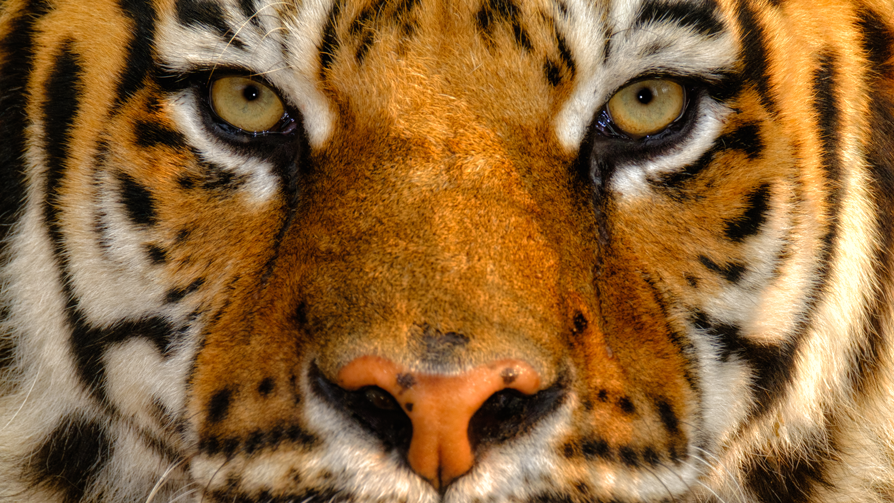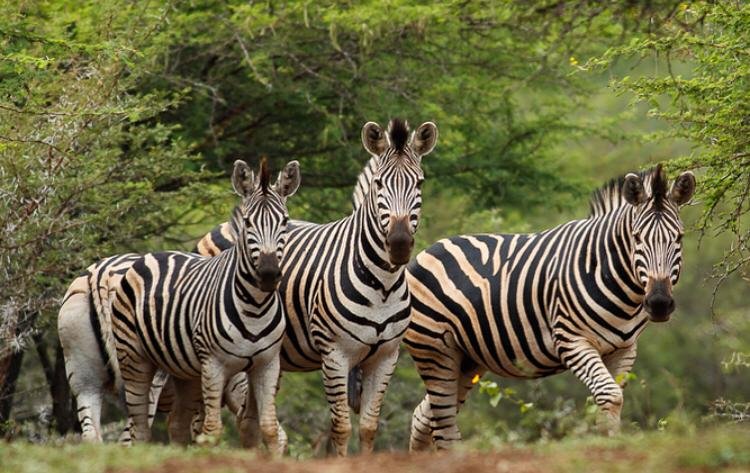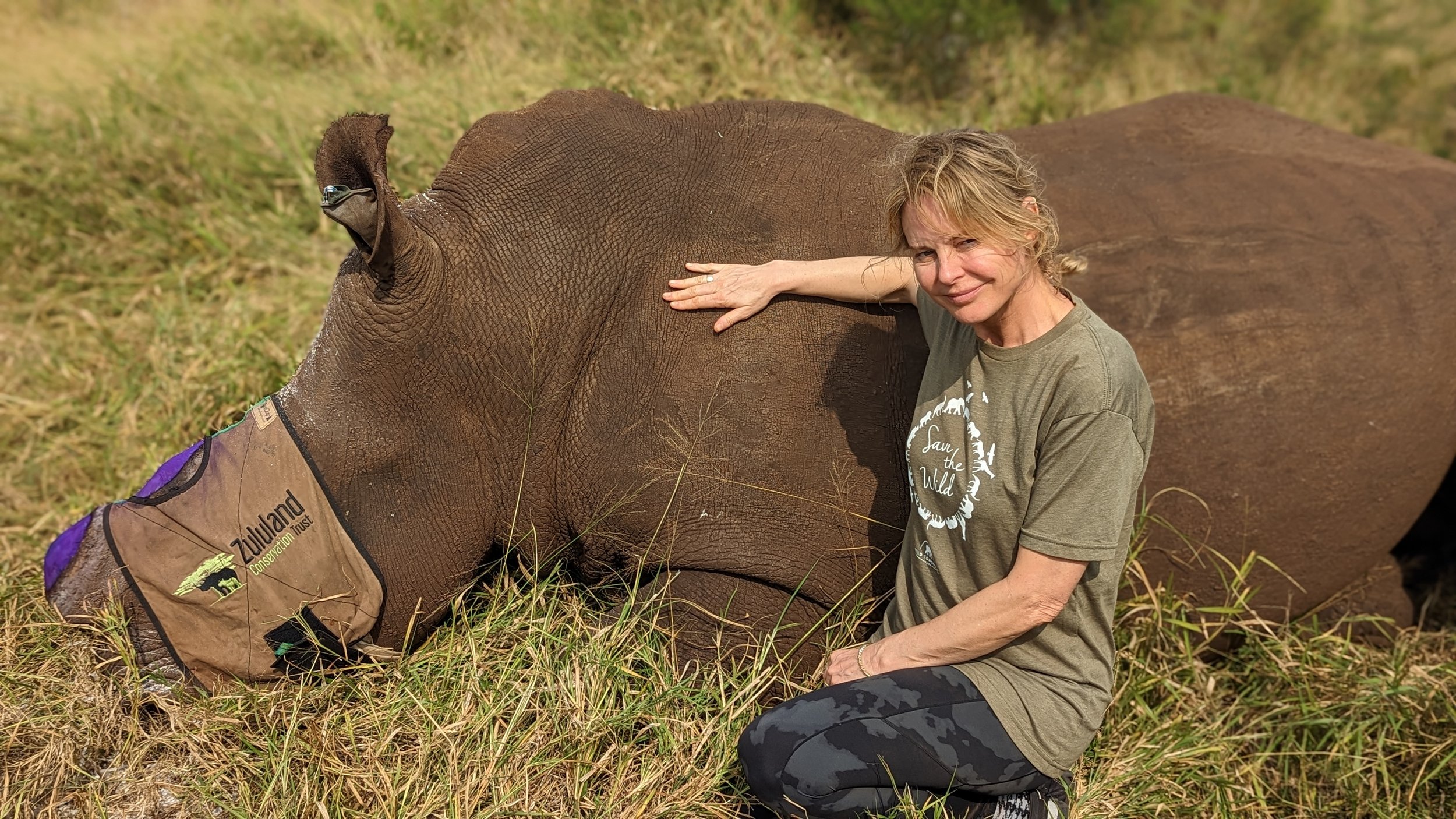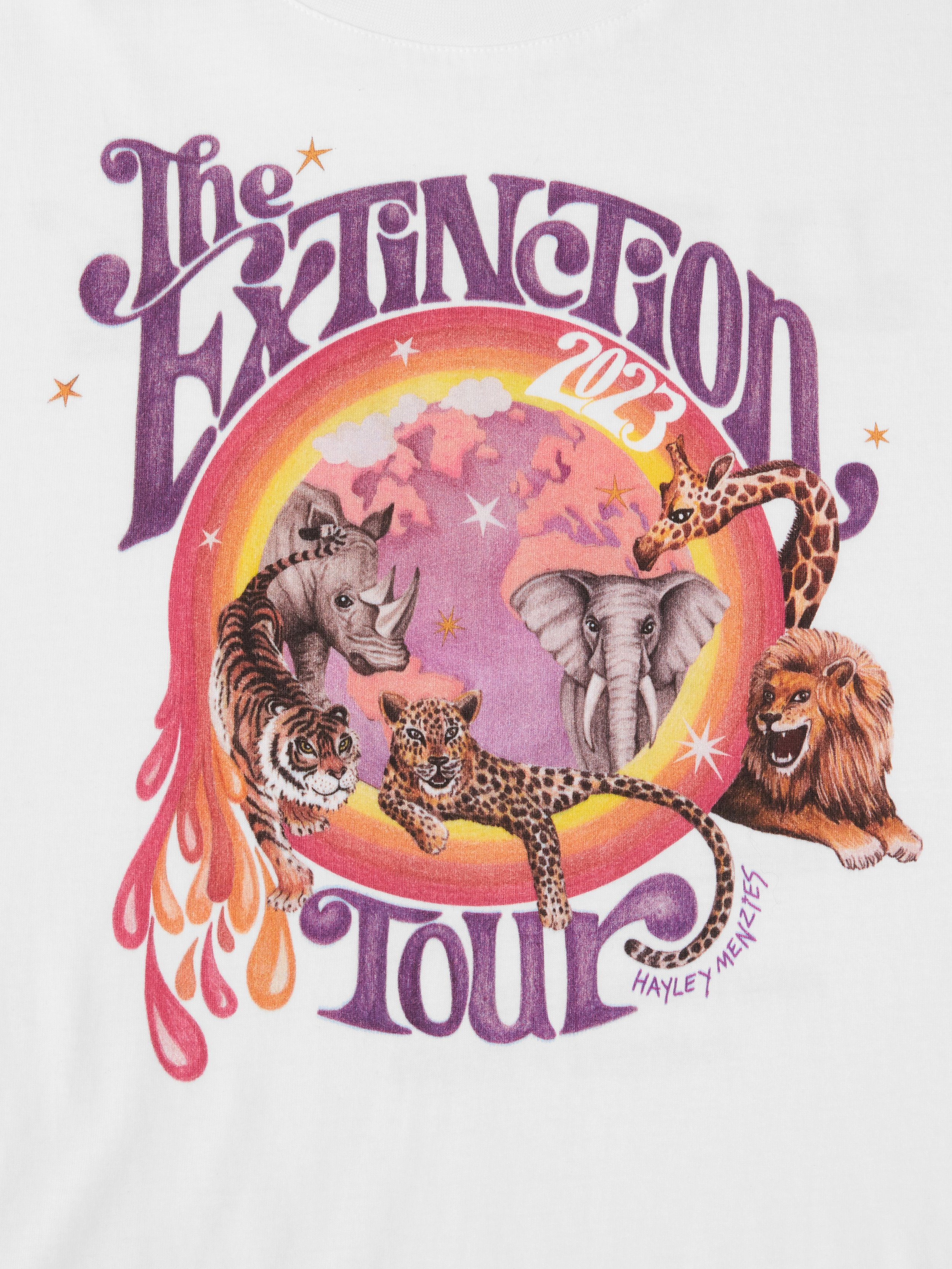THE SCIENCE BEHIND ‘THE EXTINCTION TOUR’ T-SHIRT
Wild Tomorrow is the proud beneficiary of proceeds from fashion designer Hayley Menzies’ latest t-shirt campaign. ‘The Extinction Tour’ t-shirt was made to raise awareness of the extinction faced by many of the beloved animals that have inspired her collections. Read below about the science behind the numbers on the shirt.
Wild Tomorrow’s Wendy Hapgood sat next to fashion designer Hayley Menzies at a fundraising event in the UK last year. You put two animal-loving nature enthusiasts together and the outcome is sure to be beneficial to our planet. In under a year after they met, ‘The Extinction Tour’ charity t-shirt was launched and Hayley visited our work protecting wildlife and wild places in South Africa on our April Conservation Experience Trip (more information on the trips here).
Hayley Menzies says, “The inspiration for many of our signature prints comes from nature, while its creatures – namely the leopard and tiger – have cemented themselves as our leitmotifs. As much as we take creatively, we strive to give back”. As part of an ongoing commitment, Hayley Menzies stands in solidarity with a number of animal charities and encourages customer donations on her website by featuring a charity page, the option to make an extra donation at checkout, and, now, the Extinction Tour t-shirt! Wild Tomorrow is super excited to be the benefiting charity partner for this special campaign.
It’s a sad reality that incredible wildlife around the world, including rockstar species like giraffe, rhinos, tigers, and panthers, are disappearing one by one from our planet, edging closer to extinction. It’s heartbreaking, but together we can make sure it’s not their farewell tour. When ‘The Extinction Tour’ charity t-shirt was conceptualized, a lot of research went into the figures on the back of the shirt to make sure the numbers reflect the latest population studies by conservation scientists around the world.
*LAST CHANCE TO SEE LIVE*
Lions - 25,000
Tigers - 4,500
Grevy's Zebras - 1,956
Javan Rhinos - 76
Hippos - 130,000
African Giraffes - 117,000
Asian Elephants - 50,000
Cheetahs - 7,000
Amur Leopards - 60
Panthers - 173,000
Here are a few of the sad stories about these beautiful, threatened species:
Tiger close-up by Simone Sbaraglia/Wildscreen Exchange.
Tigers (Panthera tigris) are an iconic species that everyone knows and loves – their distinguishable print is used repeatedly in fashion and design worldwide. But, seeing the figure that only 4,500 are left on the planet is quite sobering. The species has lost 93% of its historic range in the last century, with its numbers plummeting from 100,000 to around 4,500 today. Part of Hayley Menzies’ latest #HMJoyLab, creative director and musician Elliot Arndt and musician Laurel make these figures easy to visualize – all being able to fit into a single LA parking lot.
The Grevy’s Zebra (Equus grevyi) is 1 of 3 distinct zebra species, but the most endangered. Wild Tomorrow’s Greater Ukuwela Nature Reserve in South Africa is home to the Plains Zebra (Equus quagga) which is not currently a threatened or endangered species. If you traveled to Kenya, you would find only 1,956 individuals of Grevy’s Zebras. In the late 1970s/early 1980s, there were estimated to be close to 15,600 to around 2,000 in 2004 and now even less than that. Their biggest threat to population decline is habitat degradation and loss induced by extremely heavy grazing by livestock (for example cattle). Across the last two years, climate change has hit them particularly hard. Most of the remaining Grevy’s Zebra live in the arid landscapes of northern Kenya which is currently experiencing its fourth consecutive failed rainy season, causing a climatic event not seen in 40 years - and two long hard years of drought. This has wiped out 2% of the remaining population.
Common Zebra on Wild Tomorrow’s Greater Ukuwela Nature Reserve. Photograph by Wild Tomorrow Ambassador Charles Chessler.
Hayley Menzies getting hands-on with rhino conservation in South Africa with Wild Tomorrow. She is taking part in a rhino trimming - the process of ethically and humanely removing the horn from a rhino to disincentivize poachers. If you’d like to learn more about the poaching crisis and rhino dehorning/trimmings, read our blog here.
Javan rhinos (Rhinoceros sondaicus) may quite possibly be the most shocking of the figures with only 67 individuals left for the entire species. Of those 67 individuals, only 18 are mature enough to breed. And the Sumatran rhino (Dicerorhinus sumatrensis) has declined by at least 80% in the last 30 years. The combination of the extent and rate of population reduction, as well as population fragmentation, makes it perhaps the most threatened large mammal on Earth. The numbers of rhinos in Wild Tomorrow’s scope of work in/around South Africa are a bit larger, with about 16,000 Southern White rhinos (Ceratotherium simum) and 6,000 Black rhinos (Diceros bicornis) – but the country is facing a serious poaching problem and, at the current rate, we are looking at the extinction of the species within the decade (if you’d like to donate towards our rhino conservation work – you can do so here).
The South African giraffe (Giraffa camelopardalis peralta) is not a species that you would generally expect to be on the list of endangered species, but, giraffe numbers across Africa fell 40% between the 30 years of 1985 and 2015. Dr. Julian Fennessy, of the Giraffe Conservation Foundation and who co-chairs the IUCN giraffe special group, has termed it the “silent extinction”. Wild Tomorrow began reintroducing giraffe to our Greater Ukuwela Nature Reserve in 2017 as part of our habitat restoration and re-wilding program. Since then, we have welcomed a beautiful nine giraffe births to the reserve. With each giraffe calf, we celebrate the rebirth of nature – reminiscing on the fact that the land was degraded farmland just 6 years ago. More information on our habitat restoration work here.
A “journey” of giraffe of Wild Tomorrow’s Greater Ukuwela Nature Reserve in South Africa. Photographed by Wild Tomorrow Ambassador Martin Meyer.
A species that was once estimated to have 100,000 in the 1900s, Cheetahs (Acinonyx jubatus) now number less than 7,000 individuals today. The IUCN reports only 6,517 cheetahs and that this number is, unfortunately, decreasing. They are confined to only 9% of their historical distributional range and many are outside of protected areas and in small, fragmented populations, making them even more susceptible to loss of their species.
It's no question that we are losing species at an alarming rate. Did you know that one million species face extinction in our lifetimes? The number one reason that species face extinction is habitat loss. The solution to our planet’s diminishing biodiversity is protecting and enlarging wild spaces in areas rich with biodiversity. We applaud Hayley Menzies for bringing awareness to the loss of these species and we hope that the sale of ‘The Extinction Tour’ t-shirt not only brings awareness but also raises funds to continue our work protecting wildlife and wild places in South Africa.
YOU have the ability to be the difference! By purchasing ‘The Extinction Tour’ t-shirt and wearing it proudly, you can be an advocate for the lives of tigers, zebras, rhinos, giraffe, cheetahs, and more – all while looking like a rockstar!
‘The Extinction Tour’ t-shirt is available in white and acid grey colors, as well as in women’s, men’s, and children’s sizes!








